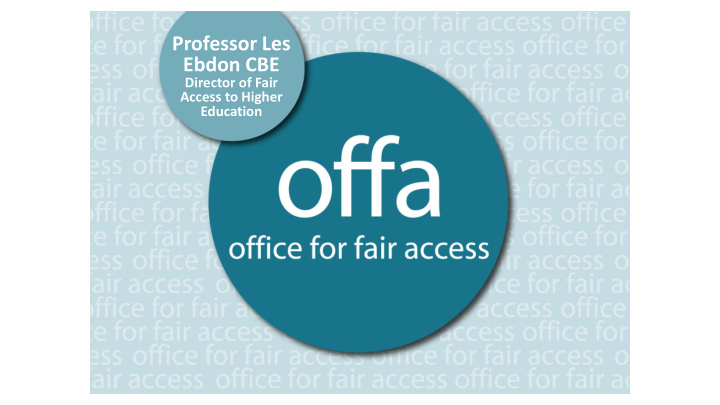



Professor Les Ebdon CBE Director of Fair Access to Higher Education
OFFA’s role To promote and safeguard fair access to higher education for people from lower income backgrounds and other under-represented groups. • Institutions charging higher fees must have an access agreement with the Director of Fair Access • Our remit covers: - full-time undergraduates - part-time undergraduates - postgraduate teacher training courses - England only.
Who are we talking about? OFFA promotes access to higher education for ‘under - represented groups’. These are: • people from lower-income backgrounds • lower socio-economic groups • students from neighbourhoods in which relatively few people enter higher education • some ethnic groups or sub-groups • people who have been in care • disabled people • young adult carers.
How we work • Put responsibility into the hands of institutions • Expanding the evidence base • Keeping access high on the public agenda (e.g. through media) • Working with others for maximum impact
Access to higher education and social mobility • Fair access to HE is a social mobility success story • Access to HE is a key driver of social mobility – “the most powerful driver of social mobility we have” (Jo Johnson) • A ‘ripple effect’ within low -participation communities • Closing the participation gap at higher tariff universities is crucial
Entry rates of disadvantaged 18 year olds in England Entry rate among the most disadvantaged, 2006-2015 (POLAR 3, Quintile 1) 20% 18.5% For 18 year olds from low participation neighbourhoods, the 2015 entry rate was 16% 18.5% , compared with 17.8% in 2014, and 13.6% in 2009 Entry Rate 12% 8% 4% Difference in entry rate between most and least disadvantaged groups 0% 2006 2009 2012 2015 4 Source: UCAS (End of cycle 2015, 18 year olds) 4 Entry rate ratio (Q5:Q1) 3 3 2 Entry rate among the least disadvantaged 18 2 year olds was 2.4 times higher than that 1 among the most disadvantaged ( down from 1 3.7 in 2006 ). 0 2006 2009 2012 2015 Source: UCAS (End of cycle 2015, 18 year olds) Q5: Least disadvantaged; Q1: Most disadvantaged
Ten years of progress…what’s behind it? • Increase in outreach • Student lifecycle approach • More tailored, evidence-based spend • More collaborative work
The challenges for widening access to higher education 1. Reducing the participation gap at higher tariff universities 2. Addressing the decline in part-time and mature student numbers 3. Addressing differential outcomes 4. Access to postgraduate study
1) Participation at higher tariff institutions Source : UCAS End of Cycle Report 2015, POLAR 3
Participation rates among most disadvantaged groups, by institution type 10.0 9.0 8.0 7.0 Higher tariff Participation rate % Medium tariff 6.0 Lower tariff 5.0 4.0 3.0 2.0 1.0 0.0 2006 2009 2012 2015 Source : UCAS End of Cycle Report 2015, POLAR 3
2) Part-time student numbers UK and other EU part-time undergraduate entrants, 2002-03 to 2014-15 Source : HEFCE Higher Education in England Key Facts, Figure 5
3) Differences in outcomes Percentage point difference of the outcome from the sector-adjusted average, split by quintile • . Source : HEFCE 2013/14, Higher education and beyond: Outcomes from full-time first degree study
Differences in outcomes by ethnicity 2013-14 graduates by ethnicity, entry qualification and degree classification Source : HEFCE 2015/21, Differences in degree outcomes: The effect of subject and student characteristics, Figure 12
4) Access to postgraduate education “Postgraduate education is in danger of becoming the new frontier of widening participation” Higher Education Commission Inquiry, 2012
Opportunities for fair access • High-level Government commitment • Green Paper • Teaching Excellence Framework (TEF)
New Government guidance “We are asking universities to go further and faster than ever before, especially the most selective institutions. This guidance identifies groups of students where most attention is needed, such as white boys from the poorest homes and students with specific learning difficulties. We want to see smarter spending, with more outreach and much deeper partnerships with local schools .” Jo Johnson MP, Minister of State for Universities and Science
Green Paper – OFFA’s response • Real opportunities for fair access • Director of Fair Access must retain independence, powers, and profile • Single focus access regulation will continue to be crucial
Teaching Excellence Framework • There are opportunities for the TEF to support progress on widening participation (WP) • BUT… WP must be prominent and meaningful in the TEF in order to guard against unintended consequences
Teaching Excellence Framework • Metrics should be disaggregated by WP characteristics • The TEF must take equality and diversity into account • Having an access agreement isn’t enough to demonstrate excellence in WP • OFFA could play a vital role in TEF assessment and review of data
Any Thank you questions? enquiries@offa.org.uk 0117 931 7171
Recommend
More recommend